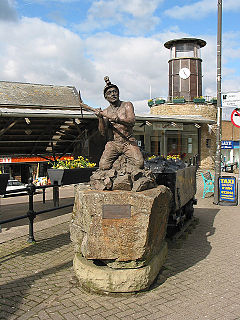Cinderford, Gloucestershire
| Cinderford | |
|---|---|
 Miners' Tribute, by Antony Dufort |
|
 Cinderford Baptist Chapel |
|
| Cinderford shown within Gloucestershire | |
| Population | 8,494 (2011 Census) |
| OS grid reference | SO6513 |
| District | |
| Shire county | |
| Region | |
| Country | England |
| Sovereign state | United Kingdom |
| Post town | Cinderford |
| Postcode district | GL14 2 |
| Dialling code | 01594 |
| Police | Gloucestershire |
| Fire | Gloucestershire |
| Ambulance | South Western |
| EU Parliament | South West England |
| UK Parliament | |
Cinderford is a small town on the eastern fringe of the Forest of Dean in Gloucestershire, England. A population of 8,116 people is recorded in the 2001 census, increasing to 8,494 in the 2011 census. The town is relatively young, coming into existence in the 19th century, following the rapid expansion of the local iron and coal industries.
A visual clue to Cinderford's origins can be seen in the style and layout of the town; with long rows of identical terraced housing; similar to many found in towns of the South Wales Valleys, that also developed around the coal mining industry. During the decline of the coal industry, in the 1950s and 1960s, Cinderford suffered more than Coleford, the other main town of the Forest, as most of the male population was employed in coal-mining. Today, Cinderford is home to a wide variety of industry, including light and heavy industry.
The name Cinderford, used for a crossing-point, is recorded as early as 1258. The name reflects the site of early ironmaking which created deposits of cinders, sometimes in large mounds.
Following the construction of Cinderford Ironworks in the late 1700s, and the opening of large mines nearby, the town was laid out on a fairly conventional urban plan. In 1841 there were two inns and at least ten beerhouses in and around Cinderford. A new church was consecrated at Cinderford in 1844 and dedicated to St. John the Evangelist. By 1843 Cinderford also had a Baptist church which became by far the largest Baptist meeting in the Forest of Dean.Methodists and Primitive Methodists also had chapels in the area, and there was even an iron building which became known as the Ark, which was registered in 1886 by a group called the Blue Ribbon Gospel Army.
...
Wikipedia

